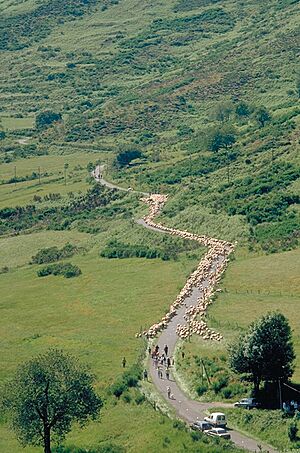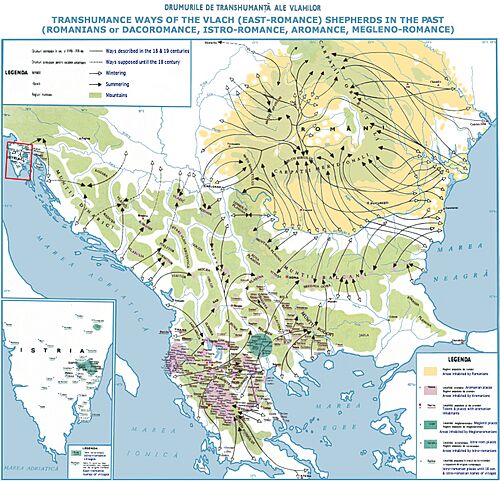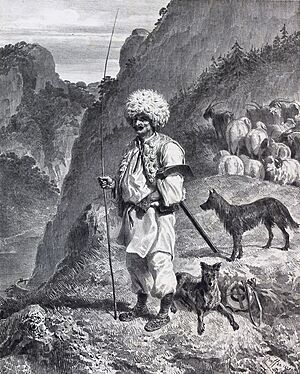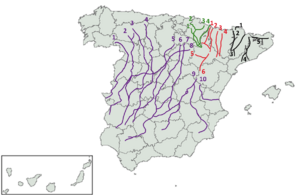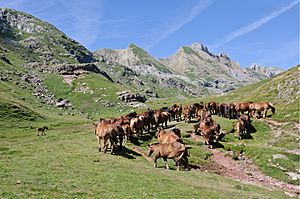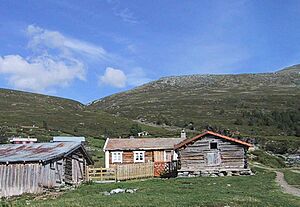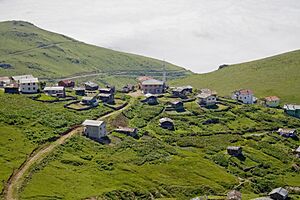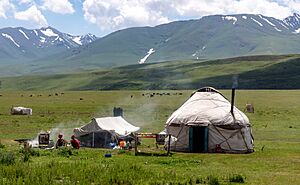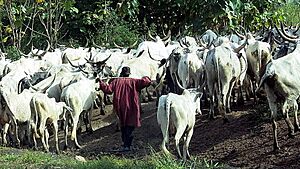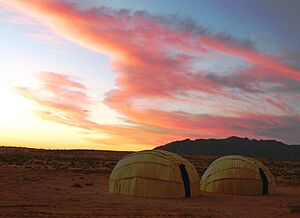Transhumance facts for kids

Transhumance is a special way of life where people move their farm animals, like sheep or cows, from one place to another depending on the season. It's like a seasonal trip for animals!
Often, this happens in mountains. Animals spend the summer high up where the grass is fresh and green. Then, when winter comes, they move down to warmer valleys. The people who care for the animals, called herders, usually have a main home in the valleys. Only the animals and a few people travel, while most of the community stays put. This is called vertical transhumance.
Sometimes, animals move across flat land instead of up and down mountains. This is called horizontal transhumance. This way of moving can be harder to keep up if the weather, money, or rules change.
This tradition has been around for a very long time, all over the world, especially in Europe and Asia. It's super important for many groups of people because the milk, butter, yogurt, and cheese from their animals are a big part of what they eat. In many languages, there are special words for these summer mountain pastures, and these words often become place names. For example, "hafod" in Wales or "alp" in Germany.
Contents
What Does Transhumance Mean?
The word transhumance comes from French. It's made from two Latin words: "trans," meaning "across," and "humus," meaning "ground." So, it means moving "across the ground."
This practice developed on every continent where people live. Even though different cultures do it in their own ways, the main idea is always the same: to use different pastures at different times of the year.
Transhumance is a type of "pastoralism," which means raising animals. It's also a form of "nomadism," which means moving from place to place. Some experts see it as a kind of "seasonal nomadism" where people move their animals to distant pastures for part of the year.
Transhumance in the Past
People have been practicing transhumance in Europe for a very long time, even before recorded history. Scientists can study old animal bones to see that animals were moved seasonally. But this practice happened all over the world, not just in Europe.
People who live in hills and mountains learned a lot about how to survive there. Herders knew about farming, raising animals, and even how to deal with forests and fast-flowing rivers. They learned these skills over many generations. Climate changes in the past also affected how these groups lived and moved their animals.
Transhumance in Europe
Alps
In the Alps, transhumance is a traditional way of life. Animals move to high mountain pastures in summer and return to lower valleys in winter.
Balkans
In the Balkans, groups like the Albanians, Greek Sarakatsani, Romanians, and Turkish Yörük people traditionally spent their summers in the mountains. They would return to warmer plains in winter. When this area was part of bigger empires, it was easier to move across borders. In summer, some groups went far north, and in winter, they moved near the Aegean Sea.
However, as new countries formed, new borders appeared. These borders made it hard for herders to move their animals between summer and winter pastures, especially during wars.
Poland
In Poland, this tradition is called redyk. It's a special ceremony when shepherds take their sheep and dogs to mountain pastures in spring. They also have a ceremony when they return in autumn.
Before the sheep left, people did special things to protect them from bad luck. They lit bonfires and led the sheep through the fire. This was meant to keep them healthy and safe. The main shepherd, called a "baca," would lead the sheep, sometimes using salt to guide them. Dogs and other shepherds helped keep the herd together. People believed that if any sheep wandered away from the group, they might die later that season.
The sheep usually stayed in the mountain pastures from April 23 (St. Wojciech's Day) until September 29 (St. Michael the Archangel's Day). This old way of grazing sheep is a reminder of how farming used to be in the Carpathian mountains.
Redyk was once a huge village festival. Farmers would mark their sheep and give them to the shepherds. All the sheep from the village would gather in one place before being driven to the mountain hut, called a "szalas." The start of the journey was loud, with shooting, honking, and shouting. This was to scare away evil spirits and keep the herd together.
After the ceremony, everyone would enjoy music and dancing. Today, Redyk is mostly a fun folk show for locals and tourists. It helps people connect with their old traditions.
Britain
Wales
In Wales, farm workers and sometimes the farmer would live in a summer house called a hafod on the hillsides. Their animals would graze there during the summer. In late autumn, they would bring the animals down to the valleys and stay at their main home, called a hendref.
This system mostly stopped about 100 years ago, though some parts of it lasted longer in Snowdonia. You can still find "Hafod" and "Hendref" as place names or house names in Wales today. Now, farmers use trucks to move their cattle and sheep to winter pastures instead of driving them overland.
Scotland
In the hilly parts of Scotland, farm workers used to spend summers in small huts called shielings. There were special paths, called drovers' roads, for moving animals. This practice has mostly stopped, but some older people still remember it happening in the Hebrides and Scottish Highlands. Today, animals are often moved by truck to lower pastures for winter.
England
People in England have practiced transhumance since the Middle Ages, from Cornwall to the north. In the Lake District, sheep are still moved between moorlands and valleys in summer and winter. This led to a system called "hefting," where sheep learn to stay in their own area of common land. However, transhumance in England was much smaller scale compared to other parts of Europe.
Ireland
In Ireland, transhumance was called "booleying." The summer pastures were known as buaile. These names still exist in many place names today. Animals, usually cattle, were moved from villages in lowlands to mountain pastures in summer. This helped the crops grow in the lowlands and gave the animals fresh grass.
Booleying has been around since early medieval times or even earlier. It was common in western Ireland until World War II. After that, people started moving to Scotland, England, or the United States for work, and this old system changed.
Italy
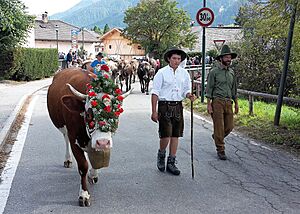
In Southern Italy, moving herds to hilly pastures in summer was common until the 1950s and 1960s, when trucks became available. Special paths called tratturi were used for this. These paths could be up to 100 meters wide and over 100 kilometers long! They allowed animals, mainly sheep, to pass and graze. Laws were made to manage these paths, and even a mounted police force was created in the 17th century. The tratturi are still public property and are protected as cultural heritage. The Molise region is even trying to get them recognized as a UNESCO World Heritage Site.
Spain
Transhumance has been very common in Spain, especially in regions like Castile and Extremadura. Herders would travel long distances with their cattle and sheep to find green pastures in summer and warmer places in winter. Spanish transhumance even influenced the cowboy cultures in the Americas, like the Gauchos in Argentina.
A network of special paths, called cañadas, crosses all of Spain. These paths have been used since ancient times. They are public land and protected by law. Some special groups of people, like the "Pasiegos" in Cantabria, are known for their transhumant lifestyle.
The Pyrenees
In the Pyrenees mountains, animals like cows, sheep, and horses are moved to high mountains for the summer. This is because farms in the lowlands are too small to feed a large herd all year. The mountain season starts in late May or early June and ends in early October.
Until the 1970s, transhumance was mainly for dairy cows, and making cheese was a big summer activity. In some areas, almost entire families would move to the mountains with their cows, living in simple stone cabins. This system, which started in the Middle Ages, lasted until the 20th century. It declined as people moved to cities for jobs. However, transhumance is still celebrated in popular festivals today.
The Mont Perdu / Monte Perdido region of the Pyrenees is a UNESCO World Heritage Site because of its connection to this farming system.
In Scandinavia, transhumance still happens, but animals are now moved by vehicles. The Sami people also practice transhumance with reindeer, but it's a different system.
The common mountain pasture used in summer is called a seter or fäbod. This word also refers to the small cabin used as a summer home. In summer, usually late June, animals are moved to these mountain farms, often far from the main farm. This saves the grass in the valleys for making hay. Girls and younger women usually took care of the animals, milking them and making cheese. When autumn arrived and the grass was gone, the animals returned home.
This practice was very common in Norway because it's so mountainous and has little flat land for farming. While many farms used to have their own seters, now several farmers often share a modern one. Many old seters are now used as vacation cabins.
Caucasus and Northern Anatolia
In the heavily forested Caucasus mountains and Pontic mountains, different groups of people still practice transhumance. In the short summer, moist air from the Black Sea helps grass grow high up in the mountains. Traditionally, villages had two, three, or even four different settlements for each season, at different heights on a mountain. Much of this changed in the 20th century as governments tried to modernize and focus on cities.
Today, many people have moved to cities for work, but tens of thousands of people still follow these traditions. For example, the Pontic Greeks visit the Sumela monastery in the summer. People from cities in Europe have even built summer homes on former grazing lands.
Sheep farming with transhumance is still done in Georgia. Shepherds and their flocks cross the 2,826-meter-high Abano Pass to move from the mountains to the plains.
Transhumance in Asia
Afghanistan
The central highlands of Afghanistan have very cold winters and cool summers. But they have mountain pastures in summer, watered by many streams. There are also warm lowland pastures for winter. This makes the region perfect for seasonal transhumance. About 225,000 square kilometers of summer pasture are used by both settled communities and nomadic herders like the Kuchis.
In Nuristan, people live in permanent villages and grow crops. Most of their animals are goats. Herdsmen take the goats to summer pastures each spring, while others stay to farm. In autumn, after the harvest, the animals return to spend winter in stables.
India
Jammu and Kashmir in India has the largest transhumant population in the world. A survey in 2021 found over 612,000 people from tribal communities like Gujjars and Bakkerwals who practice transhumance. The government has started many programs to help these communities with healthcare, education, and transportation. Most of these people move within Jammu and Kashmir, but some travel to neighboring states. The Gujjar-Bakkerwal tribe makes up almost all of the transhumant population in Jammu and Kashmir.
The Bhotiya communities of Uttarakhand also used to practice transhumance. They spent winters in low-altitude villages and summers in high-altitude settlements. Some would farm, others would trade in Tibet, and some would be nomadic herders. This way of life stopped suddenly after the 1962 war with China closed the border.
Iran
The Bakhtiari tribe of Iran still lived this way in the mid-20th century. Along the Zagros Mountains, animal-raising tribes move back and forth each year between their permanent homes in the valley and homes in the foothills.
The Qashqai tribe of southern Iran also practiced transhumance in the mid-20th century. They moved their animals from south to north, living in high mountains from April to October. In autumn, they left the highlands to spend winter in warmer areas near the Mond River. Their migrations were carefully organized by the Qashqai Chief. They avoided towns because their huge flocks of millions of animals could cause damage.
Lebanon
You can find examples of transhumance in the North Governorate of Lebanon. Towns like Ehden and Kfarsghab are used in summer, from June to mid-October. Inhabitants move in October to coastal towns. This movement was historically for farming, like raising silkworms. The main crops in coastal towns are olives, grapes, and citrus, while mountain towns grow summer fruits like apples and pears.
Kyrgyzstan
In Kyrgyzstan, transhumance never stopped, even during Soviet times. It has become even more important since 1991. Transhumance is a big part of Kyrgyz culture. People use a special felt tent called a yurt when they live on summer pastures. The yurt is even on their national flag! Shepherds in Kyrgyzstan enjoy a fermented drink made from mare's milk called kumis. The tool used to make it is the namesake for Bishkek, the country's capital city.
South and East Asia
Transhumance is found in temperate areas of the Himalaya and in the cold, dry areas north of the Himalaya, through the Tibetan Plateau and northern China.
Countries like Mongolia, China, Kazakhstan, Kyrgyzstan, Bhutan, India, Nepal, and Pakistan still have parts of transhumance cultures. In Mongolia, transhumance helps prevent animals from dying during harsh winters. In the Himalaya, transhumance is still vital for many communities, like those in Zanskar in India, or the Van Gujjars and Bakarwals of Jammu and Kashmir. Sometimes, the distances people travel with their animals are so great that it's considered true nomadic pastoralism.
Transhumance in Oceania
Australia
In Australia, where there are many large ranches, workers called stockmen move herds to seasonal pastures.
Transhumant grazing is an important part of the cultural history of the Australian Alps. Colonists started using this region for summer grazing in the 1830s. This practice helped make animal farming possible in Australia. It created a unique way of life that is a big part of Australia's pioneering history. You can still see signs of this history, like old stockman's huts and stock routes.
Transhumance in Africa
North Africa
The Berber people of North Africa were traditionally farmers. However, the Tuareg and Zenaga of the southern Sahara practice nomadic transhumance. Other groups, like the Chaouis, practiced fixed transhumance.
Horn of Africa
In Northeast Africa, the Somali and Afar also traditionally practice nomadic transhumance. They mainly raise camels, along with sheep and goats.
Classic, "fixed" transhumance is practiced in the Ethiopian Highlands. During the planting season, lands around villages cannot be grazed. So, farmers move their animals to distant grazing grounds, often deep in valleys or on mountain tops. The animals stay there overnight with children and a few adults watching them.
For example, cattle from Addi Geza'iti are brought to the Tsaliet River gorge every rainy season, where there is lots of vegetation. The cattle keepers build shelters for the animals and themselves, often in rock caves. The cattle stay there until harvest time, when they are needed for threshing, and when the leftover crops become available for grazing.
East Africa
The Pokot community in northwestern Kenya and eastern Uganda are semi-nomadic herders. They move seasonally between grasslands in Kenya and Uganda.
The Maasai are semi-nomadic people in Kenya and northern Tanzania. Their transhumance culture is centered around their cattle.
Nigeria
The Fulani are a group of nomadic herders in Nigeria. They raise most of Nigeria's cattle. Cattle are very important to these communities, providing meat, milk, and power for farming. Selling cattle also brings in money and helps protect against problems.
However, raising animals this way is becoming harder in Africa. Before the 1950s, herders and farmers worked together. During the dry season, herders moved south where there was plenty of grass. In the wet season, they moved north to avoid tsetse flies, which carry diseases. They would trade dairy products with farmers, and after harvest, their cattle would graze on leftover crops, leaving behind valuable manure.
Angola
In Southern Angola, groups like the Ovambo and part of the Nyaneka-Khumbi organize their lives completely around transhumance.
Lesotho
The traditional way of life for the Basotho people in Lesotho is raising cattle. They move their animals seasonally between valleys and the high plateaus of the Maloti Mountains. However, there is now more pressure on grazing land because the population has grown, and large dams have been built in the mountains to provide water to South Africa. This pressure is harming the grasslands and changing the traditional transhumance patterns.
South Africa
In South Africa, the Nama clan of the Khoikhoi still lives a transhumance lifestyle in the Richtersveld. This is a mountain desert area near the Atlantic coast. People move seasonally, three or four times a year, with their sheep and goats. This transhumance is based on small family groups who use the same camps each year.
A special portable tent, called a Matjieshut or Haru Oms, is a key part of Khoikhoi culture. These homes are used in their seasonal camps. They have a frame covered with rush mats. Today, people sometimes use other materials. The Richtersveld has been named a UNESCO World Heritage Site because of its importance.
Transhumance in North America
In the southern Appalachians of the United States in the 1800s and early 1900s, settlers often grazed animals, especially sheep, on grassy mountain tops. These "balds" might have been old bison grazing lands. Without transhumance, these grassy areas are now becoming covered by forests.
Transhumance, often using public land, is still an important way of ranching in the western United States. In northern areas, herds move to higher ground in spring and summer as mountain pastures turn green. These uplands are often part of large public lands managed by the United States Forest Service. In winter, herds use lower plains or deserts, which are also often government lands.
In California and Texas, more land is privately owned. In summer, ranch families or hired shepherds travel to the mountains and stay in small camps. They might also visit the mountain ranch regularly, using trailers to bring horses.
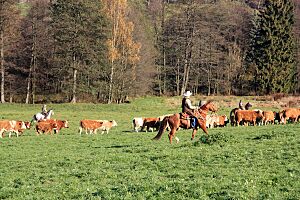
Traditionally in the American West, shepherds spent most of the year with their sheep, looking for the best grass. This was most common in the late 1800s. Cattle and sheep herds usually start on private land, but they use much larger areas of land throughout the year. Some farmers hired Basque shepherds to care for the herds. Now, workers from Peru, Chile, and Mongolia often take on these roles. Shepherds take sheep into the mountains in summer and to the desert in winter, sometimes using leftover crops on private land.
The Navajo people started practicing transhumance in the 1850s after they were forced from their homeland. They still raise many sheep.
In California, ranches often have more private land because of old Spanish land grants. These ranches depend on summer grazing on government land.
Transhumance in South America
In South America, transhumance involves "cowboy" figures like the gaucho in Argentina, Uruguay, Paraguay, and southern Brazil. There are also the llanero in Venezuela and the huaso in Chile.
Transhumance is currently practiced in Argentina, Chile, Peru, Bolivia, and the Brazilian Pantanal. It mainly involves moving cattle in the Pantanal and parts of Argentina. In the Altiplano, indigenous communities raise llamas. Goats are moved in northern Neuquén and southern Mendoza, while sheep are more common in the Patagonian plains. Both local people and indigenous groups use transhumant practices in South America.
See also
- Altitudinal migration
- Kuchis
- Rarámuri
- Sarakatsani
- Seasonal human migration
- Yaylak


